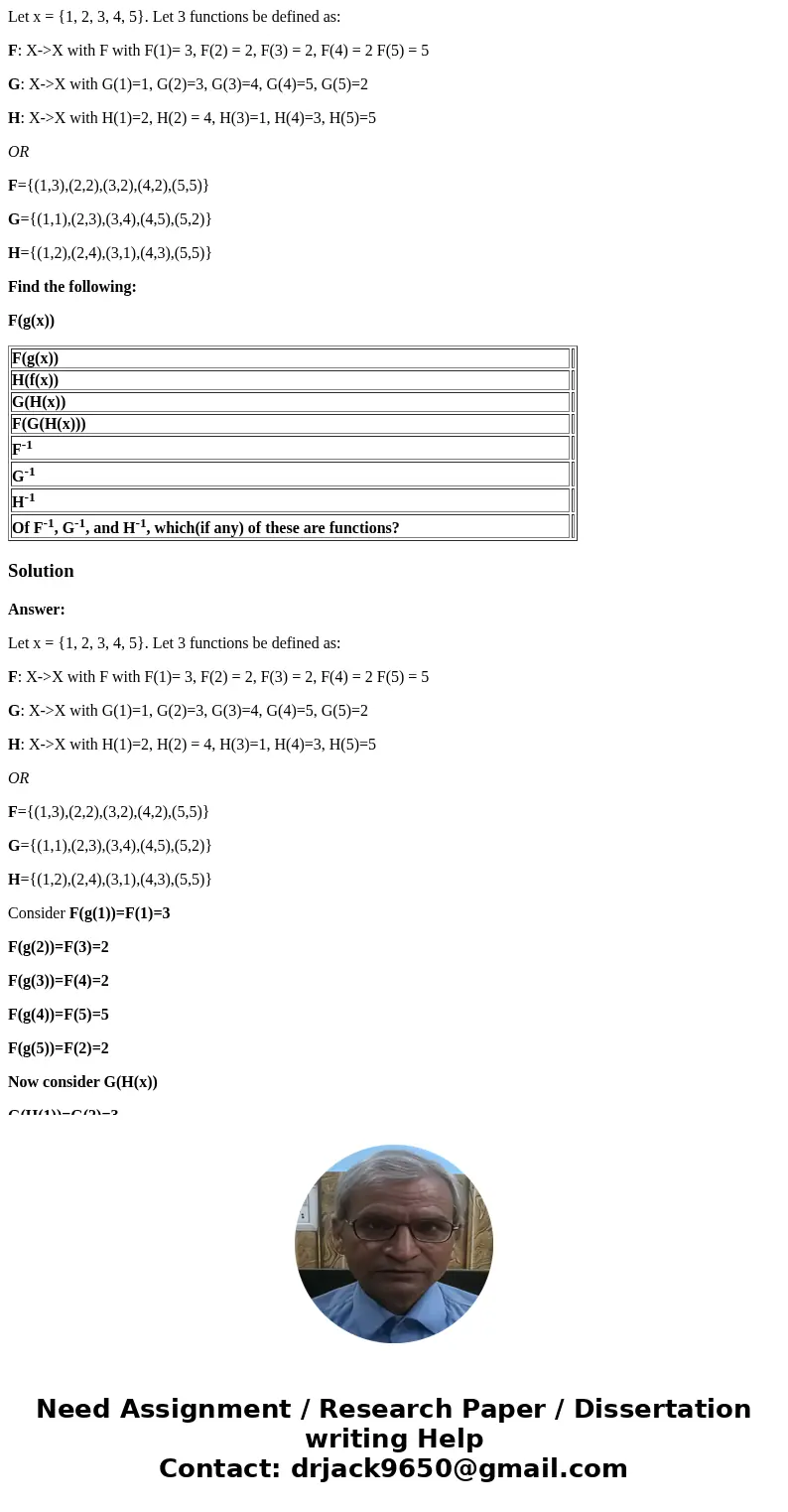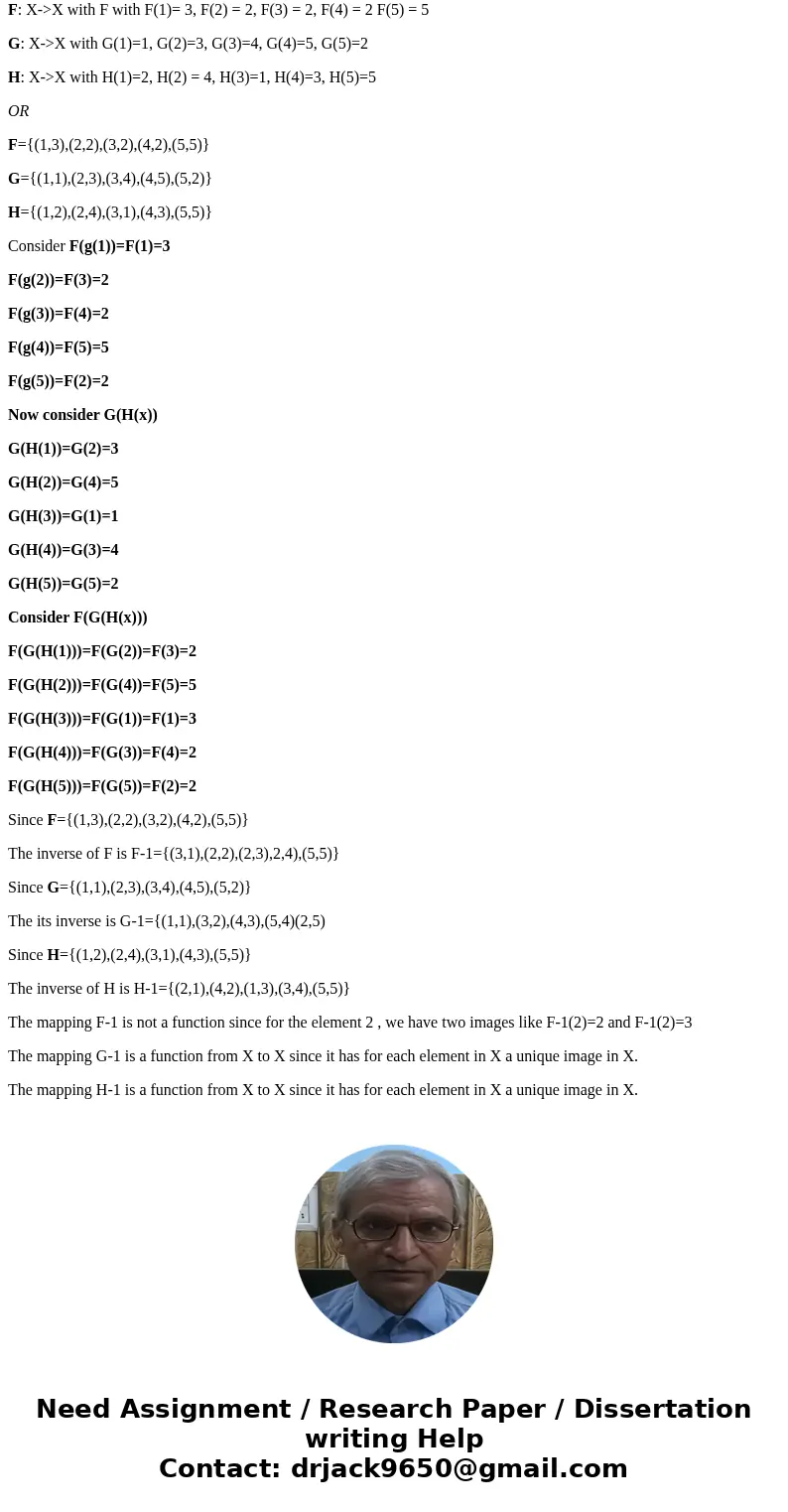Let x 1 2 3 4 5 Let 3 functions be defined as F XX with F w
Let x = {1, 2, 3, 4, 5}. Let 3 functions be defined as:
F: X->X with F with F(1)= 3, F(2) = 2, F(3) = 2, F(4) = 2 F(5) = 5
G: X->X with G(1)=1, G(2)=3, G(3)=4, G(4)=5, G(5)=2
H: X->X with H(1)=2, H(2) = 4, H(3)=1, H(4)=3, H(5)=5
OR
F={(1,3),(2,2),(3,2),(4,2),(5,5)}
G={(1,1),(2,3),(3,4),(4,5),(5,2)}
H={(1,2),(2,4),(3,1),(4,3),(5,5)}
Find the following:
F(g(x))
| F(g(x)) | |
| H(f(x)) | |
| G(H(x)) | |
| F(G(H(x))) | |
| F-1 | |
| G-1 | |
| H-1 | |
| Of F-1, G-1, and H-1, which(if any) of these are functions? |
Solution
Answer:
Let x = {1, 2, 3, 4, 5}. Let 3 functions be defined as:
F: X->X with F with F(1)= 3, F(2) = 2, F(3) = 2, F(4) = 2 F(5) = 5
G: X->X with G(1)=1, G(2)=3, G(3)=4, G(4)=5, G(5)=2
H: X->X with H(1)=2, H(2) = 4, H(3)=1, H(4)=3, H(5)=5
OR
F={(1,3),(2,2),(3,2),(4,2),(5,5)}
G={(1,1),(2,3),(3,4),(4,5),(5,2)}
H={(1,2),(2,4),(3,1),(4,3),(5,5)}
Consider F(g(1))=F(1)=3
F(g(2))=F(3)=2
F(g(3))=F(4)=2
F(g(4))=F(5)=5
F(g(5))=F(2)=2
Now consider G(H(x))
G(H(1))=G(2)=3
G(H(2))=G(4)=5
G(H(3))=G(1)=1
G(H(4))=G(3)=4
G(H(5))=G(5)=2
Consider F(G(H(x)))
F(G(H(1)))=F(G(2))=F(3)=2
F(G(H(2)))=F(G(4))=F(5)=5
F(G(H(3)))=F(G(1))=F(1)=3
F(G(H(4)))=F(G(3))=F(4)=2
F(G(H(5)))=F(G(5))=F(2)=2
Since F={(1,3),(2,2),(3,2),(4,2),(5,5)}
The inverse of F is F-1={(3,1),(2,2),(2,3),2,4),(5,5)}
Since G={(1,1),(2,3),(3,4),(4,5),(5,2)}
The its inverse is G-1={(1,1),(3,2),(4,3),(5,4)(2,5)
Since H={(1,2),(2,4),(3,1),(4,3),(5,5)}
The inverse of H is H-1={(2,1),(4,2),(1,3),(3,4),(5,5)}
The mapping F-1 is not a function since for the element 2 , we have two images like F-1(2)=2 and F-1(2)=3
The mapping G-1 is a function from X to X since it has for each element in X a unique image in X.
The mapping H-1 is a function from X to X since it has for each element in X a unique image in X.


 Homework Sourse
Homework Sourse